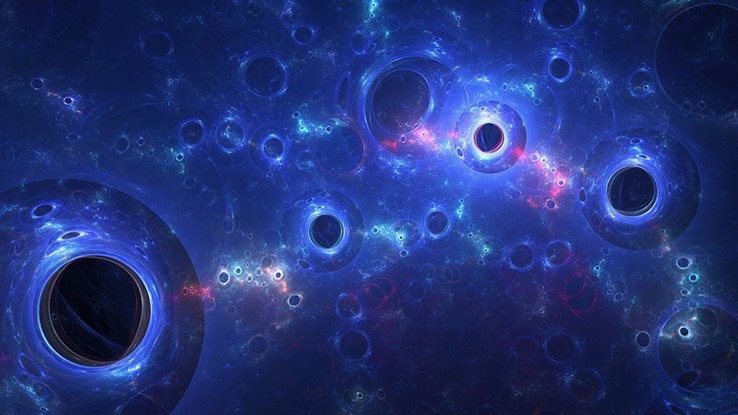

Cosmox Blogs
Dark Matter
What is Dark Matter? Dark matter is a form of matter thought to account for approximately 85% of the matter in the universe. Its existence is implied in a lot of astrophysical observations, including gravitational effects that cannot be explained by proved theories of gravity unless more matter is present that can be seen. Due to this reason, many physicists think of dark matter as an abundant in the universe which has had a strong influence on its structure and evolution.

Dark matter is called dark because it doesn’t interact with electromagnetic field, which means it does not absorb, reflect or emit electromagnetic radiation, and is therefore difficult to detect.
Evidence of Dark Matter -
Evidence for dark matter comes from numerous calculations showing that many galaxies would fly apart, or they would not have formed or would not move as they do, if they did not contain large amount of undiscovered matter. Other lines of evidence include observations in gravitational lensing and in the cosmic microwave background along with astronomical observations of the observable universe's current structure, the formation of billions of galaxies, mass location during galactic collisions, and the motion of galaxies within galaxy clusters. In the standard Lambda-CDM model of cosmology.

The total mass energy of the universe contains 5% ordinary matter and energy, 27% dark matter, and 68% form of energy known as dark energy.
Because dark matter has not yet been observed directly, if it exists, it must barely interact with ordinary baryonic matter and radiation, except through gravity. Most dark matter is thought to be non-baryonic in nature; it may be composed of some as-yet-undiscovered subatomic particles. The primary candidate for dark matter is some new kind of elementary particle that has not yet been discovered, in particular, weakly interacting massive particles (WIMPs). Many experiments to directly detect and study dark matter particles are being actively undertaken, but none have yet succeeded. Dark matter is classified as "cold", "warm", or "hot" according to its velocity (more precisely, its free streaming length). Current models favor a cold dark matter scenario, in which structures emerge by the gradual accumulation of particles.
Observation Evidence -
Galaxy rotation curves
The arms of spiral galaxies rotate around the galactic center. The luminous mass density of a spiral galaxy decreases as one goes from the center to the outskirts. If luminous mass were all the matter, then we can model the galaxy as a point mass in the center and test masses orbiting around it, similar to the Solar System. From Kepler's Second Law, it is expected that the rotation velocities will decrease with distance from the center, similar to the Solar System. This is not observed. Instead, the galaxy rotation curve remains flat as the distance from the center increases.
If Kepler's laws are correct, then the obvious way to resolve this discrepancy is to conclude the mass distribution in spiral galaxies is not similar to that of the Solar System. In particular, there is a lot of non-luminous matter (dark matter) in the outskirts of the galaxy.

Galaxy Clusters -
Galaxy clusters are particularly important for dark matter studies since their masses can be estimated in three independent ways:
- From the scatter in radial velocities of the galaxies within clusters
- From X-rays emitted by hot gas in the clusters. From the X-ray energy spectrum and flux, the gas temperature and density can be estimated, hence giving the pressure; assuming pressure and gravity balance determines the cluster's mass profile. - Gravitational lensing (usually of more distant galaxies) can measure cluster masses without relying on observations of dynamics (e.g., velocity).
Generally, these three methods are in reasonable agreement that dark matter outweighs visible matter by approximately 5 to 1.

Gravitational Lensing -
One of the consequences of general relativity is massive objects (such as a cluster of galaxies) lying between a more distant source (such as a quasar) and an observer should act as a lens to bend the light from this source. The more massive an object, the more lensing is observed.
Strong lensing is the observed distortion of background galaxies into arcs when their light passes through such a gravitational lens. Weak gravitational lensing investigates minute distortions of galaxies, using statistical analyses from vast galaxy surveys. By examining the apparent shear deformation of the adjacent background galaxies, the mean distribution of dark matter can be characterized. The mass-to-light ratios correspond to dark matter densities predicted by other large-scale structure measurements. Dark matter does not bend light itself; mass (in this case the mass of the dark matter) bends spacetime. Light follows the curvature of spacetime, resulting in the lensing effect.
Cosmic Microwave Background -
Although both dark matter and ordinary matter are matter, they do not behave in the same way. In particular, in the early universe, ordinary matter was ionized and interacted strongly with radiation via Thomson scattering. Dark matter does not interact directly with radiation, but it does affect the CMB by its gravitational potential (mainly on large scales), and by its effects on the density and velocity of ordinary matter. Ordinary and dark matter perturbations, therefore, evolve differently with time and leave different imprints on the cosmic microwave background (CMB).

Structure Formation -
Structure formation refers to the period after the Big Bang when density perturbations collapsed to form stars, galaxies, and clusters. Prior to structure formation, the Friedmann solutions to general relativity describe a homogeneous universe. Later, small anisotropies gradually grew and condensed the homogeneous universe into stars, galaxies and larger structures. Ordinary matter is affected by radiation, which is the dominant element of the universe at very early times. As a result, its density perturbations are washed out and unable to condense into the structure. If there were only ordinary matter in the universe, there would not have been enough time for density perturbations to grow into the galaxies and clusters currently seen.
Dark matter provides a solution to this problem because it is unaffected by radiation. Therefore, its density perturbations can grow first. The resulting gravitational potential acts as an attractive potential well for ordinary matter to collapse later, speeding up the structure formation process.

Bullet Cluster -
If dark matter does not exist, then the next most likely explanation must be that general relativity – the prevailing theory of gravity – is incorrect and should be modified. The Bullet Cluster, the result of a recent collision of two galaxy clusters, provides a challenge for modified gravity theories because its apparent center of mass is far displaced from the baryonic center of mass. Standard dark matter models can easily explain this observation, but modified gravity has a much harder time, especially since the observational evidence is model-independent.
Detection of Dark Matter Particle -
If dark matter is made up of subatomic particles, then millions, possibly billions, of such particles must pass through every square centimeter of the Earth each second.
Direct Detection -
Direct detection experiments aim to observe low-energy recoils (typically a few keVs) of nuclei induced by interactions with particles of dark matter, which (in theory) are passing through the Earth. After such a recoil the nucleus will emit energy in the form of scintillation light or phonons, as they pass through sensitive detection apparatus. To do this effectively, it is crucial to maintain a low background, and so such experiments operate deep underground to reduce the interference from cosmic rays. Examples of underground laboratories with direct detection experiments include the Stawell mine, the Soudan mine, the SNOLAB underground laboratory at Sudbury, the Gran Sasso National Laboratory, the Canfranc Underground Laboratory, and the Boulby Underground Laboratory, the Deep Underground Science and Engineering Laboratory, and the China Jinping Underground Laboratory.
Indirect Detection -
Indirect detection experiments search for the products of the self-annihilation or decay of dark matter particles in outer space. For example, in regions of high dark matter density (e.g., the center of our galaxy) two dark matter particles could annihilate to produce gamma rays or Standard Model particle–antiparticle pairs.
A few of the dark matter particles passing through the Sun or Earth may scatter off atoms and lose energy. Thus dark matter may accumulate at the center of these bodies, increasing the chance of collision/annihilation. This could produce a distinctive signal in the form of high-energy neutrinos. Such a signal would be strong indirect proof of WIMP dark matter. High-energy neutrino telescopes such as AMANDA, Ice Cube and ANTARES are searching for this signal. The detection by LIGO in September 2015 of gravitational waves opens the possibility of observing dark matter in a new way, particularly if it is in the form of primordial black holes.

Alternative Hypotheses -
Because dark matter has not yet been identified, many other hypotheses have emerged aiming to explain the observational phenomena that dark matter was conceived to explain. The most common method is to modify general relativity. General relativity is well-tested on solar system scales, but its validity on galactic or cosmological scales has not been well proven. A suitable modification to general relativity can conceivably eliminate the need for dark matter. The best-known theories of this class are MOND and its relativistic generalization tensor- vector-scalar gravity (TeVeS), f(R) gravity, negative mass, dark fluid, and entropic gravity. Alternative theories abound
Conclusion -
The prevailing opinion among most astrophysicists is that while modifications to general relativity can conceivably explain part of the observational evidence, there is probably enough data to conclude there must be some form of dark matter present in the Universe.

Cosmox Blogs
A non profit organization that works on writing and delivering blogs on cosmology, natural sciences & environment, so that people can learn more about it. We even run a forums page, where our users interacts with each other and discuss about Cosmology, Natural Sciences & Astronomy. We even run an instagram and a youtube channel with podcasts.